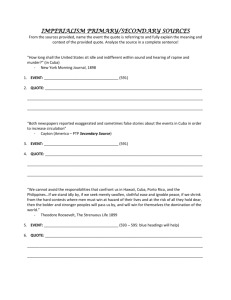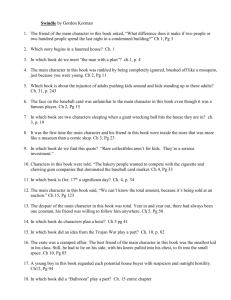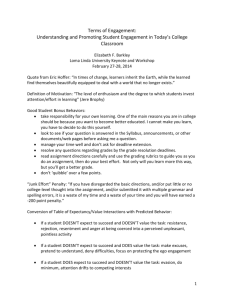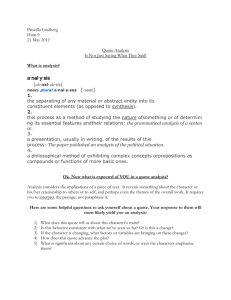Integrating Quotations into Your Sentences
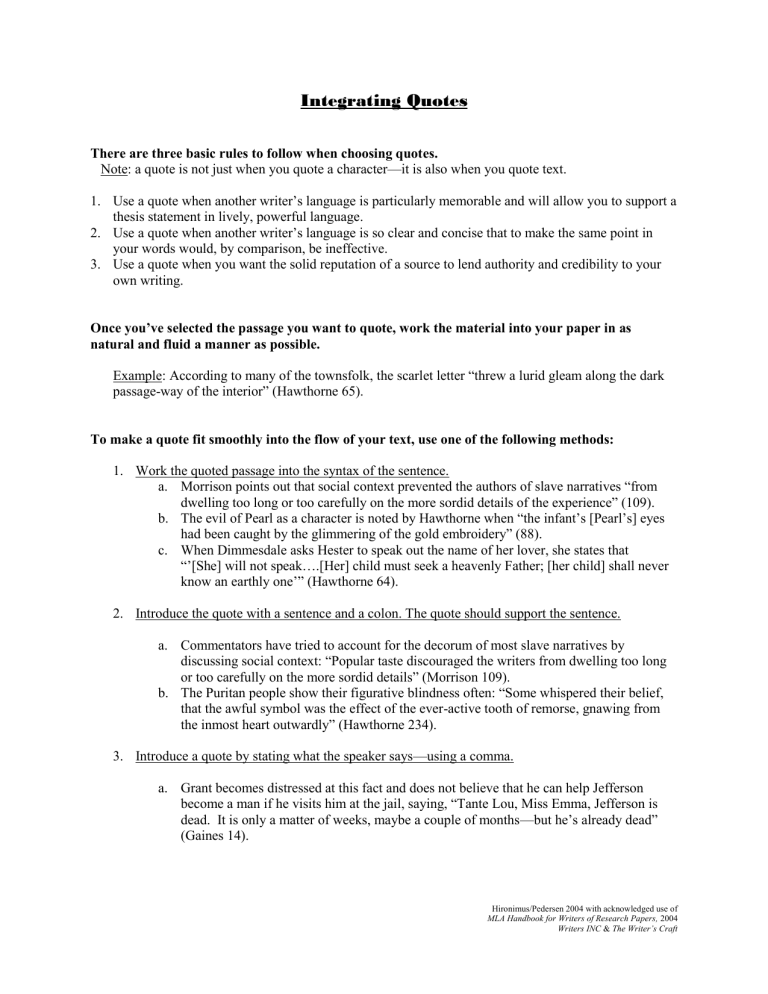
Integrating Quotes
There are three basic rules to follow when choosing quotes.
Note: a quote is not just when you quote a character—it is also when you quote text.
1.
Use a quote when another writer’s language is particularly memorable and will allow you to support a thesis statement in lively, powerful language.
2.
Use a quote when another writer’s language is so clear and concise that to make the same point in your words would, by comparison, be ineffective.
3.
Use a quote when you want the solid reputation of a source to lend authority and credibility to your own writing.
Once you’ve selected the passage you want to quote, work the material into your paper in as natural and fluid a manner as possible.
Example: According to many of the townsfolk, the scarlet letter “threw a lurid gleam along the dark passage-way of the interior” (Hawthorne 65).
To make a quote fit smoothly into the flow of your text, use one of the following methods:
1.
Work the quoted passage into the syntax of the sentence. a.
Morrison points out that social context prevented the authors of slave narratives “from dwelling too long or too carefully on the more sordid details of the experience” (109). b.
The evil of Pearl as a character is noted by Hawthorne when “the infant’s [Pearl’s] eyes had been caught by the glimmering of the gold embroidery” (88). c.
When Dimmesdale asks Hester to speak out the name of her lover, she states that
“’[She] will not speak….[Her] child must seek a heavenly Father; [her child] shall never know an earthly one’” (Hawthorne 64).
2.
Introduce the quote with a sentence and a colon. The quote should support the sentence. a.
Commentators have tried to account for the decorum of most slave narratives by discussing social context: “Popular taste discouraged the writers from dwelling too long or too carefully on the more sordid details” (Morrison 109). b.
The Puritan people show their figurative blindness often: “Some whispered their belief, that the awful symbol was the effect of the ever-active tooth of remorse, gnawing from the inmost heart outwardly” (Hawthorne 234).
3.
Introduce a quote by stating what the speaker says—using a comma. a.
Grant becomes distressed at this fact and does not believe that he can help Jefferson become a man if he visits him at the jail, saying, “Tante Lou, Miss Emma, Jefferson is dead. It is only a matter of weeks, maybe a couple of months—but he’s already dead”
(Gaines 14).
Hironimus/Pedersen 2004 with acknowledged use of
MLA Handbook for Writers of Research Papers, 2004
Writers INC & The Writer’s Craft
You may have to change around a quote to make it fit your syntax. For instance…
1.
Use an ellipsis to quote the beginning and end of a passage but not its middle. a.
In fact, “two or three times…Pearl looked up, with mischief gleaming in her black eyes” (Hawthorne 166).
2.
Add a period to the ellipses if the first part of the quote is the end of a sentence. a.
Hester is greeted at the prison-door by the town beadle, but “she repelled him….
She bore in her arms a child” (Hawthorne 50).
3.
Use brackets to indicate words added by you for clarification. a.
The evil of Pearl as a character is noted by Hawthorne when “the infant’s
[Pearl’s] eyes had been caught by the glimmering of the gold embroidery” (88).
4.
Use brackets to replace names or pronouns in order to maintain agreement. a.
When Dimmesdale asks Hester to speak out the name of her lover, she states that
“’[She] will not speak….[Her] child must seek a heavenly Father; [her child] shall never know an earthly one’” (Hawthorne 64).
5.
Use slashes to indicate the end of a line of poetry. a.
Anglelou’s call “Shine on me, sunshine / Rain on me, rain / Fall softly, dewdrops”(15-17) conveys her desire to shift away from the monotony of housework.
6.
Set off a passage of four or more lines with a colon; then indent the passage. a.
Nathaniel Hawthorne, in the opening of The Scarlet Letter , illustrates the severity of the Purtian code:
The founders of a new colony, whatever utopia of human virtue and happiness they might originally project, have invariably recognized it among their earliest practical necessities to allot a portion of the virgin soil as a cemetery, and another portion as the site of a prison. (45)
Note: You do not use quotation marks in this instance, and you do not place the final period after the citation. The parentheses of the citation are placed one space after the final period.
For more on integrating quotations into your essay, consult Writer’s Inc.
pages 107, 250, 258, 469.
Hironimus/Pedersen 2004 with acknowledged use of
MLA Handbook for Writers of Research Papers, 2004
Writers INC & The Writer’s Craft




